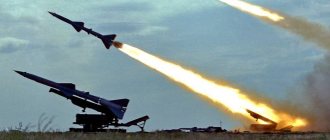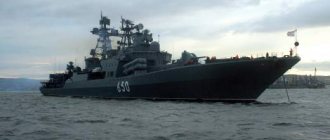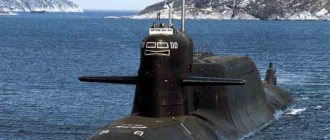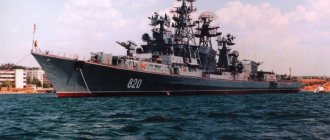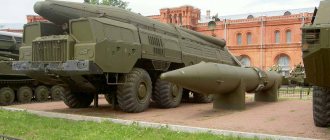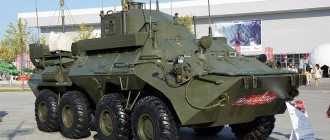Characteristics of the URK-5 “Rastrub” universal missile system
A country:USSRType:Universal missile systemDate of issue:1984Calculation:Caliber:rocket torpedo 85RULength:3585 mm (rocket-torpedo 85RU)Width:Weight:Rate of fire:There are 2 missiles in a salvo.Firing distance:90 km, flight altitude 750 m. In water: 8 km, travel depth 500 m.Initial projectile speed:Speed in water 41 knotsAmmunition:
“The Soviet universal missile system URK-5 “Rastrub” and the 85RU torpedo missile. Design and features of combat use"
Development[edit]
In the early 1960s, the Soviet Union introduced the RBU-6000 and RBU-1000 anti-submarine missile launchers, which operated on the same principle as the Royal Navy's World War II Hedgehog system, dropping small depth charges to depths of up to 5,800 meters. (6300 yards) from the ship. However, this meant that the ship would still be within range of the submarine's torpedoes and missiles, and depth charges were less accurate than homing torpedoes. In 1963, the US Navy introduced the ASROC missile, which flew to the intended position of a target submarine and then dropped a torpedo into the water to destroy it. The SS-N-14 was the Soviet answer.
In 1993, an upgraded version of the YP-85 with a range of 250 km (130 mi) was offered for export. [2]
The history of the creation of URK-5 “Ball”
The universal missile system URK-5 "Rastrub " and the anti-submarine guided cruise missile 85RU were created in pursuance of the Resolution of the Council of Ministers of the USSR No. 302-116 “On the development of work on the creation of underwater weapons” (1976), which provided for the development of a number of fundamentally new anti-submarine systems and research works
The development was carried out by the Raduga ICB of the Ministry of Aviation Industry; the URPK-3 Metel complex, already in service, was taken as a basis.
After development and testing, in 1984, the URK-5 “Rastrub” was put into service and began to be implemented on ships of the active fleet. The first to receive the new weapon system were large anti-submarine ships, Project 1134A and Project 1134B.
The main purpose of the complex was the destruction of both underwater and surface targets. That is why the URK-5 “Rastrob” complex included not just a missile, but a guided cruise missile-torpedo 85RU (85RUS - with a nuclear charge).
Installation of URK-5 “Rasstrub” on a Project 1155 ship
Anti-submarine missile systems "Metel" and "Rastrub-B"
In accordance with the resolution of the Council of Ministers, issued in October 1960, the Soviet defense industry developed three new anti-submarine missile systems, two of which were put into service. Already in the mid-sixties, it was decided to continue work in this direction and create new anti-submarine systems. By the beginning of the seventies, several projects of new missile systems were created.
Launch of 85RU from BOD pr. 1155 (photo from the Chinese site iask.sina.com.cn)
URPK-3 and URPK-4 “Metel”
The first new system of this class was the URPK-3 “Metel” complex. The development of the complex was entrusted to the Raduga MKB (Dubna) and the Altair Research Institute (Moscow). The chief designer of the project was A.Ya. Bereznyak (MKB "Raduga"), work at the Altair Research Institute was led by G.N. Volgin. In addition to the Raduga ICB, several other organizations were involved in the project, creating various components of the new rocket and the entire complex. In accordance with the technical specifications, the URPK-3 “Metel” anti-submarine complex was intended for surface ships of projects 1134A and 1134B. Some time after the start of development, the fleet expressed a desire to equip ships of other types with the Metel complex. The version of the system for arming ships of projects 1135 and 1135M received the designation URPK-4 and retained the “name”. Due to other requirements determined by the characteristics of the ships, the URPK-4 complex received a new launcher and control system.
A unique photograph of the KT-100 launcher (most likely a BOD pr. 1134B), which simultaneously houses two 85RU missile-torpedoes of the Rastrub complex (on the left) and two 85R missiles of the Metel complex (photo by D. Nelson from rbase.new -factoria.ru)
The main element of both Metel complexes was the 84R guided missile. For the first time in domestic practice, the anti-submarine complex received a cruise missile. The 7.2 m long rocket had a cylindrical body with a diameter of 0.58 m with a delta-shaped wing and front horizontal tail mounted on it. The launch weight of the rocket is about 3.8 tons. A keel was provided at the rear of the hull. The AT-2UM torpedo, developed at the Gidropribor Research Institute, was to be suspended under the rocket body. To increase combat effectiveness, the missile body was equipped with its own warhead, thanks to which the ammunition could hit surface targets if necessary.
URPK-3 "Metel" in its pure form - 85R rocket-torpedoes in the KT-100 launcher BOD pr. 1134A "Admiral Yumashev" (photo from moremhod.info)
The 84R rocket received a solid fuel engine, which allowed it to reach speeds of up to 0.95M. The delivery of the torpedo was ensured at a distance of 6 to 50 km from the carrier ship. After launch, the rocket had to rise to a height of 400 m and maintain it until reaching the target area. Unlike previous domestic anti-submarine missiles, the ammunition of the Metel complex received a radio command control system. The ship's onboard equipment, using a hydroacoustic station or other similar systems, was supposed to determine the location of the target and generate commands to control the missile. Thus, the missile could be launched into the target area taking into account the latter’s maneuvers.
Having arrived in a given area, the 84R rocket was supposed to drop a torpedo. To avoid damage during splashdown, the AT-2UM torpedo was equipped with a parachute system. After splashdown, the torpedo sank to the depth of the expected location of the target and began a circulation search. Moving at a speed of 23 knots, the AT-2UM torpedo used a two-plane acoustic guidance system with a response radius of up to 1000 m. After detecting a target, the torpedo was supposed to accelerate to 40 knots. The ammunition range was 8 km, the maximum depth of destruction of the target was 400 m. The warhead carried 100 kg of explosives.
The main difference between the URPK-3 and URPK-4 complexes is the launchers used. Thus, on ships of projects 1134A and 1134B it was proposed to use two KT-106 launchers with containers for four missiles on each. It was proposed to place two launchers of this type at the sides of the ship, under the wing of the navigation bridge. Horizontal guidance was provided within a small sector limited by the ship's superstructure. There were hinged covers on the front wall of the launchers. The missiles were placed inside the launcher and held in place by guides located on the top side of the inner surface of the container. To control the launcher and the missile system as a whole, Project 1134 ships used the Grom-M system.
PU KT-100M URK "Rastrub" with four 85RU missile-torpedoes on the BOD pr.1155 (photo from the Myanmar Navy page on facebook.com)
The architecture of patrol ships of projects 1135 and 1135M forced the authors of the Metel project to change the design of the launcher. At the bow of these ships was installed a KT-100 launcher with four missile containers located side by side. This launcher could be rotated in a horizontal plane and thereby simplified the use of anti-submarine missiles. Along with a launcher for four missiles, Project 1135 ships used the Monsoon control system.
The URPK-3 Metel anti-submarine missile system with the 84R guided missile was put into service in 1973. Its first carriers were 10 ships of Project 1134A and 7 ships of Project 1134B. Soon the URPK-4 complex with a different launcher and control system was put into service. Anti-submarine complexes of the Metel family were actively used until the mid-eighties, after which they began to be replaced by newer systems.
URK-5 "Rastrub-B"
Back in 1976, the Dubna IKB Raduga and the Altair Research Institute were tasked with developing a new anti-submarine missile system with higher performance. The new project was named URK-5 “Rastrub-B”. The URK-5 anti-submarine complex represents a deep modernization of the Metel family of systems. Thus, its 85RU guided missile became an updated and improved version of the old 84R. The general features of the complex remained the same, but numerous improvements led to a noticeable increase in its characteristics.
The main element of the Rastrub-B complex was still a cruise guided missile with a solid propellant engine, carrying a small-sized torpedo. The dimensions and weight of the 85RU rocket remained at the level of the corresponding parameters of the 84R product. At the same time, the launch weight of the rocket increased to 4 tons, and the maximum launch range increased to 55 km. The terms of reference for the URK-5 project implied the creation of a universal missile system, which, in particular, was reflected in the letter “U”. For this reason, the missile received an infrared homing head and a 185-kg warhead. With the help of these components, the 85RU missile could attack enemy surface ships.
The missile launcher of the URK-5 complex was borrowed from the URPK-3 Metel system. As before, the ship could carry two launchers with four missiles each. The KT-106 launchers retained the capability of limited horizontal aiming. The fire control system of the Rastrub-B complex was a modified version of the Monsoon system. Due to the specific requirements for the complex, it received an additional mode for firing at surface targets. Thus, when attacking an underwater target, the missile had to fly at an altitude of 400 m, and when firing at surface ships, the ammunition did not rise above 15-20 m.
85RU missile-torpedoes in the KT-106M launcher of the SKR “Pylkiy” pr. 11352 (photo from forums.airbase.ru from Pytlivy808)
A small-sized torpedo UMGT-1 developed by the Gidropribor Research Institute was proposed as the warhead of an anti-submarine missile. The maximum speed of the new torpedo was 41 knots, the diving depth was up to 500 m. The range remained at the level of the previous torpedo of the Metel complex and was 8 km. In addition, the response radius of the guidance system has increased to 1.5 km. The general algorithms for the operation of the URK-5 "Rastrub-B" complex, such as the launch process, the flight of the rocket and the attack of an enemy submarine with a torpedo, were similar to the operation of the systems of the "Metel" family.
The URK-5 complex was adopted by the USSR Navy in 1984. During repairs, these anti-submarine systems were installed on existing ships, incl. projects 1134 and 1135, and were also mounted on new equipment for the fleet. The following projects received the Rastrub-B system: 1134A, 1134B, 1135, 1135M, 11352 and 1155. Some of these ships still serve in the Russian Navy.
Slightly edited diagram of the 85RU missile-torpedo of the Rastrub complex from A. Pavlov’s book “Udaloy-type BOD” (1-19)
Rocket torpedo 85RU of the Rastrub complex in the museum of the history of the Raduga small design bureau (photo by E. Erokhin, Vzlyot magazine No. 12/2006, p. 55)
The 85RU missile itself - the pylon is clearly visible, from which a container with a torpedo and a nuclear warhead is suspended (photo from moremhod.info)
Based on materials from: https://flot.sevastopol.info/ https://zonwar.ru/ https://rbase.new-factoria.ru/ Shirokorad A.B. Weapons of the domestic fleet. 1945-2000. – Mn.: “Harvest”, 2001
Options [edit]
- 60R - Original version, armed with a 5 kt nuclear depth charge.
- 70R - The original version, armed with the AT-2U anti-submarine torpedo.
- 83R / URPK-3 " Metel"
- a cruising version of the missile with a guidance system from the SA-N-3 missile and the KT-106 launcher. Uses the AT-1 torpedo (EA-45-70A) - PU 84R/URPK-4 Metel-U
, KT-106U, used on the destroyers Udaloy. Entered service in 1973. Uses the AT-2 (AT-2UM) torpedo (E53-72), which has either a 100 kg high explosive warhead or possibly a 5 kt nuclear warhead. - 85RU/URPK-5 Bell
, KT-100U launcher. Entered service in 1975. It carries the UGMT-1 (AT-3 Orlan) anti-submarine and anti-ship torpedo, as well as an anti-ship missile with a 185 kg warhead. 85RUS/URPK-5 Missile with a nuclear warhead.
History of operations[edit]
URPK-3 entered service in 1969 on the Cross II and Kara class cruisers. [2] URPK-4 was introduced in 1973, and the anti-ship version URPK-5 "Rastrob" was introduced in 1976. [2] URPK-4 was used on the Burevestnik-class frigate and the first batch of Udaloy-class destroyers; The Udaloy II carries the SS-N-15 Starfish. The system was installed on the Admiral Ushakov
(formerly
Kirov
), but not on her sister ships. [2]
Of these, Cresta and all but two Caras retired, along with most of the petrels and half of the daredevils; Kirov
appears to have been upgraded to SS-N-16 "stallion" at some point. It is estimated that 100 missiles will remain in service as of 2006 [Update].
Design[edit]
The missile is based on the P-120 Malachite anti-ship missile (NATO: SS-N-9 Siren). The rocket itself is radio-controlled and powered by a solid-fuel rocket motor. Later models of the "Rastrob" weapon were "universal" with the multi-purpose torpedo UGMT-1 and, in addition, had a cumulative warhead weighing 185 kg for use against ships controlled by radio and IR-seeker. [3] In anti-submarine mode, the missile flew at an altitude of approximately 400 meters, and when it was above the estimated position of the target submarine, the missile was given the command to release a torpedo or depth charge. In anti-ship mode, the missile flies much lower, at 15 meters. [1]
